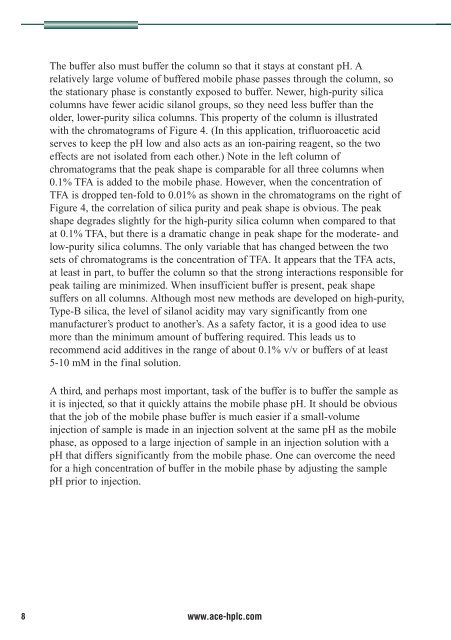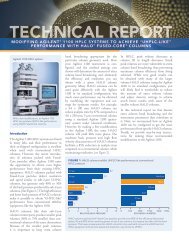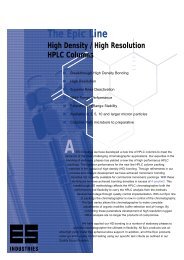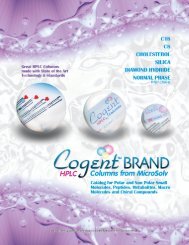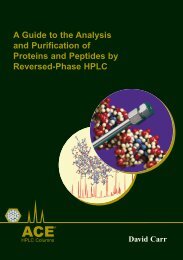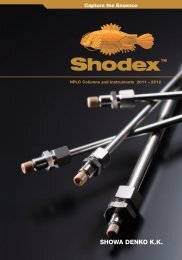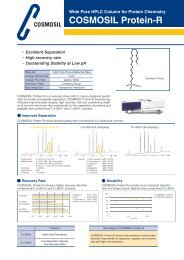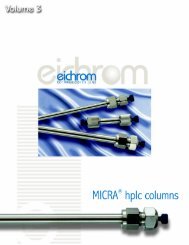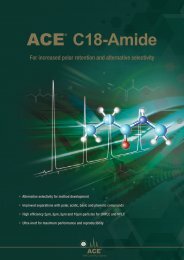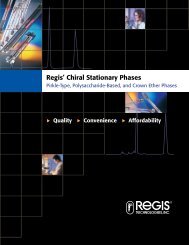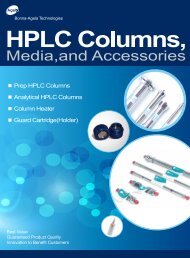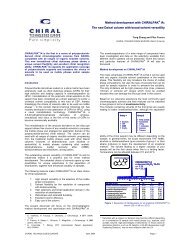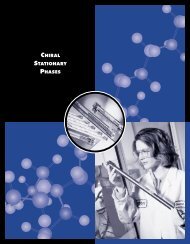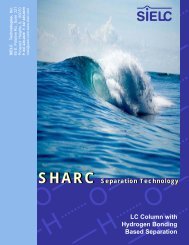A Guide to HPLC & LC-MS Buffer Selection - by John W ... - Hplc.eu
A Guide to HPLC & LC-MS Buffer Selection - by John W ... - Hplc.eu
A Guide to HPLC & LC-MS Buffer Selection - by John W ... - Hplc.eu
Create successful ePaper yourself
Turn your PDF publications into a flip-book with our unique Google optimized e-Paper software.
The buffer also must buffer the column so that it stays at constant pH. A<br />
relatively large volume of buffered mobile phase passes through the column, so<br />
the stationary phase is constantly exposed <strong>to</strong> buffer. Newer, high-purity silica<br />
columns have fewer acidic silanol groups, so they need less buffer than the<br />
older, lower-purity silica columns. This property of the column is illustrated<br />
with the chroma<strong>to</strong>grams of Figure 4. (In this application, trifluoroacetic acid<br />
serves <strong>to</strong> keep the pH low and also acts as an ion-pairing reagent, so the two<br />
effects are not isolated from each other.) Note in the left column of<br />
chroma<strong>to</strong>grams that the peak shape is comparable for all three columns when<br />
0.1% TFA is added <strong>to</strong> the mobile phase. However, when the concentration of<br />
TFA is dropped ten-fold <strong>to</strong> 0.01% as shown in the chroma<strong>to</strong>grams on the right of<br />
Figure 4, the correlation of silica purity and peak shape is obvious. The peak<br />
shape degrades slightly for the high-purity silica column when compared <strong>to</strong> that<br />
at 0.1% TFA, but there is a dramatic change in peak shape for the moderate- and<br />
low-purity silica columns. The only variable that has changed between the two<br />
sets of chroma<strong>to</strong>grams is the concentration of TFA. It appears that the TFA acts,<br />
at least in part, <strong>to</strong> buffer the column so that the strong interactions responsible for<br />
peak tailing are minimized. When insufficient buffer is present, peak shape<br />
suffers on all columns. Although most new methods are developed on high-purity,<br />
Type-B silica, the level of silanol acidity may vary significantly from one<br />
manufacturer’s product <strong>to</strong> another’s. As a safety fac<strong>to</strong>r, it is a good idea <strong>to</strong> use<br />
more than the minimum amount of buffering required. This leads us <strong>to</strong><br />
recommend acid additives in the range of about 0.1% v/v or buffers of at least<br />
5-10 mM in the final solution.<br />
A third, and perhaps most important, task of the buffer is <strong>to</strong> buffer the sample as<br />
it is injected, so that it quickly attains the mobile phase pH. It should be obvious<br />
that the job of the mobile phase buffer is much easier if a small-volume<br />
injection of sample is made in an injection solvent at the same pH as the mobile<br />
phase, as opposed <strong>to</strong> a large injection of sample in an injection solution with a<br />
pH that differs significantly from the mobile phase. One can overcome the need<br />
for a high concentration of buffer in the mobile phase <strong>by</strong> adjusting the sample<br />
pH prior <strong>to</strong> injection.<br />
8 www.ace-hplc.com


